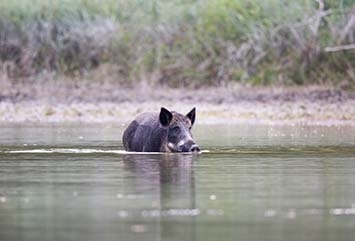NWRC Spotlight - Feral Swine Impacts to Water Quality

Riparian habitats play a vital role in filtering pollutants and sediment from water, thus improving water quality and ensuring adequate nutrient cycling. Riparian areas also provide valuable habitat for plants and animals, surface water storage, agriculture and livestock production, and recreational opportunities for people.
The presence of livestock and wildlife in and near riparian areas can lead to contamination of streams through direct contact or from runoff polluted with feces and urine. Subsequent use of contaminated water has been linked to disease outbreaks in people. Feral swine may significantly contaminate and alter the functionality of riparian ecosystems given their ability to dig and overturn soil which can lead to increased erosion and runoff.
NWRC and Auburn University scientists compared the water quality of streams from watersheds on a privately owned property in Alabama with a dense pig population and a nearby national forest without an established pig population. Water samples were collected twice monthly for a year. Results showed that feral swine introduced fecal material and bacteria to the streams. Watersheds with feral swine had elevated dissolved organic carbon and total nitrogen attributable to feral swine feces. Furthermore, watersheds with feral swine had Escherichia coli values that were 40 times higher than watersheds without feral swine. E. coli can sometimes cause severe illnesses, such as diarrhea, urinary tract infections, respiratory illness, and bloodstream infections.
This study is the first to definitively link feral swine presence to the introduction of fecal material and waterborne pathogens in watersheds.
For more information, please contact NWRC@usda.gov

